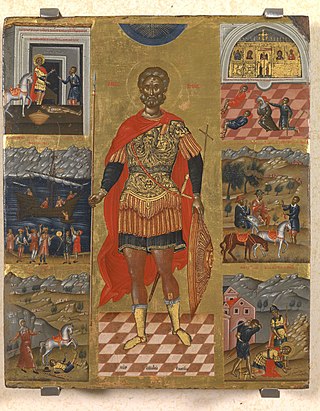
Cretan school describes an important school of icon painting, under the umbrella of post-Byzantine art, which flourished while Crete was under Venetian rule during the late Middle Ages, reaching its climax after the Fall of Constantinople, becoming the central force in Greek painting during the 15th, 16th and 17th centuries. The Cretan artists developed a particular style of painting under the influence of both Eastern and Western artistic traditions and movements; the most famous product of the school, El Greco, was the most successful of the many artists who tried to build a career in Western Europe, and also the one who left the Byzantine style farthest behind him in his later career.

The Heptanese school of painting succeeded the Cretan school as the leading school of Greek post-Byzantine painting after Crete fell to the Ottomans in 1669. Like the Cretan school, it combined Byzantine traditions with an increasing Western European artistic influence and also saw the first significant depiction of secular subjects. The school was based in the Ionian Islands, which were not part of Ottoman Greece, from the middle of the 17th century until the middle of the 19th century. The center of Greek art migrated urgently to the Ionian islands but countless Greek artists were influenced by the school including the ones living throughout the Greek communities in the Ottoman Empire and elsewhere in the world.
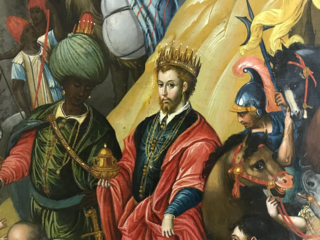
Michael Damaskenos or Michail Damaskenos was a leading post-Byzantine Cretan painter. He is a major representative of the Cretan School of painting that flourished in the 16th and 17th centuries. Painters Georgios Klontzas and Damaskenos were major contributors to the Cretan School during the same period. Damaskinos traveled all over the Venetian Empire painting. He remained loyal to his Greek roots stylistically but incorporated some Italian elements in his work. He was strongly influenced by the Venetian school. He painted parts of the Cathedral of San Giorgio dei Greci. Damaskenos has 100 known works. He influenced the works of Theodore Poulakis.

San Giorgio dei Greci is a church in the sestiere (neighborhood) of Castello, Venice, northern Italy. It was the center of the Scuola dei Greci, the Confraternity of the Greeks in Venice. Around this period there was a similar church in Naples called Santi Pietro e Paolo dei Greci. There was also a Greek Brotherhood of Naples.

Christ Bearing the Cross is a painting in tempera attributed to the Greek painter Nikolaos Tzafouris. Tzafouris is considered one of the founding members of the Cretan School along with Andreas Ritzos, Andreas Pavias, and Angelos Akotantos. He was influenced by Angelos Akotantos. According to the Institute of Neohellenic Research, thirteen paintings are attributed to Tzafouris. Active between 1480 and 1501, Tzafouris had a workshop in Heraklion, where he painted religious themes for local churches. His most notable works are the Madre della Consolazione and Christ Bearing the Cross.

Ilias or Elias Moskos was a Greek educator, shipping merchant and painter from Crete. The last name Moskos was associated with three famous painters of the Cretan School alive during the same period, along with Ioannis Moskos and Leos Moskos, possibly his relatives. Elias incorporated maniera greca with the Venetian style. Theodore Poulakis and Moskos brought the art and style of Crete into the Heptanese School of the Ionian Islands. Some of his work was inspired by Angelos Akotantos. He was affiliated with other artists such as Philotheos Skoufos. He is often confused with Leos Moskos. His son was not Ioannis Moskos although they were probably related. Elias most popular painting is Christ Pantocrator. Fifty-two of his paintings survived.
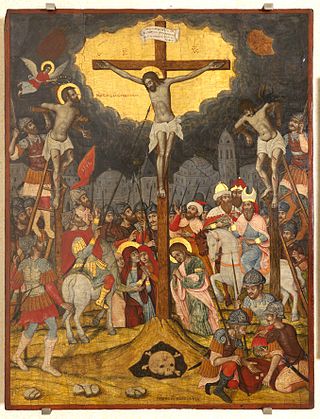
Ioannis Moskos was a Greek painter that migrated to Venice. Two other very famous painters with the name Moskos were active around the same period Elias Moskos and Leos Moskos. Leos Moskos frequently traveled all over the Venitian Empire and was in Venice around the same period as Ioannis. He is not Elias Moskos's son. The Moskos painters may have had some relationship but documentation is unavailable. Ioannis painted in the traditional maniera greca and the Venetian style. His art resembles Michael Damaskinos and Andreas Pavias. He was affiliated with the church of San Giorgio dei Greci. He left a huge assortment of paintings that can be found all over the world. His most popular work is The Crucifixion.

Andreas Karantinos, also known as Andreas Karandinos. He was Greek Renaissance painter, educator and goldsmith. He was from Kefalonia. He was a member of the Heptanese School. His artwork is reflective of the time period. His teacher was famous painter Stephanos Tzangarolas. He adapted his style. Karandinos also emulated the Cretan masters such as Michael Damaskinos. Many Greek painters emulated one other. Karandinos also taught famous Greek painter Konstantinos Kokkinos and several others. Many of his works are in Greece mostly on the island of Kefalonia. Twenty two of his work survived and one fresco. The fresco is of the Second Coming or the Last Judgement. The fresco is located in the church of Evagelastria in Kastro Kefalonia.
Manolis Chatzidakis was a Greek Byzantinist. He significantly contributed to the history of art of Greece. He specialized in the field of Byzantine and Post-Byzantine painting. He is considered the 20th century Giorgio Vasari and Bernardo de' Dominici. He was an archeologist, art historian, author, lecturer and curator. He also spoke Arabic and contributed to the field of Islamic art. He helped saved countless artifacts.

The Stoning of Saint Stephen is an egg tempera and gold leaf painting created by Greek master Michael Damaskinos. He was a member of the Cretan school. He integrated Venetian painting with the Greek mannerisms prevalent at the time. Damaskinos was active in Heraklion, Sicily, Venice, and other parts of Italy. The Stoning of Stephen has been depicted by countless Greek and Italian painters. Saint Stephen was a protomartyr. He was the first martyr of Christianity. He was stoned to death for following the new faith. The painting is a depiction of that event.

The Last Judgement Triptych is a triptych by Georgios Klontzas. Klontzas was a Greek painter and prominent member of the Cretan School. He is likened to El Greco and Michael Damaskinos. His artistic period was between 1550 and 1608. He had a workshop in Heraklion, Crete. He created many forms of art such as triptychs, portable icons or paintings, and manuscripts. Klontzas created several versions of the Last Judgment or Second Coming. His The Last Judgment also features the same theme but is a painting, not a triptych. Klontzas also created other triptychs.

Saint Theodora is a tempera painting by Emmanuel Tzanes. Emmanuel Tzanes was a priest and painter. He was from Crete. He migrated to Venice with his two brothers, painter Konstantinos Tzanes and poet Marinos Tzanes. Emmanuel was a priest at San Giorgio dei Greci. The painters remaining works number over 130. He painted in the Greek mannerisms prevalent at the time. Empress Theodora is one of the most important figures in Greek-Italian Byzantine art history. She ended the second scourge of iconoclasm. The word literally means image breaking. Countless priceless icons and paintings were destroyed. The empress was a savior to artists. The painting is at the Byzantine Museum in Athens, Greece.
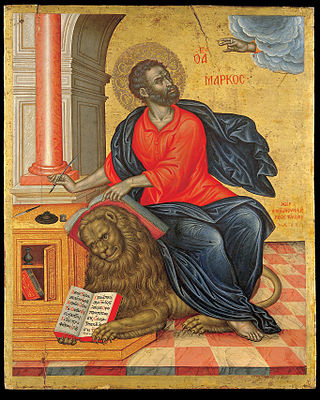
Saint Mark is a tempera-on-wood painting created c. 1657 by Emmanuel Tzanes. Tzanes was a Cretan painter who migrated to Corfu and Venice. He settled in Venice with his brothers Konstantinos Tzanes and poet Marinos Tzanes. Konstantinos was a famous painter. Their combined existing works number over 150. Emmanuel replaced Greek painter Philotheos Skoufos as the priest of San Giorgio dei Greci.
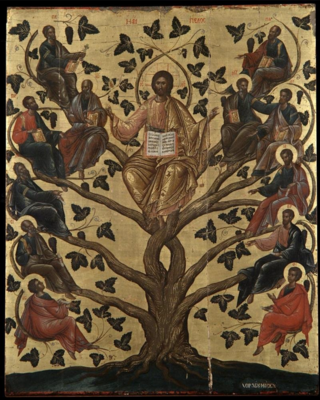
Christ the Vine, also known as the Tree of Christ, is a tempera painting by Leos Moskos. Moskos was active from 1620 to 1690. Twenty of his works have survived. He was originally from Rethimno, Crete. He traveled all over the Venetian empire. He worked on the Ionian islands of Cephalonia and Zakynthos. He also worked in Venice. Two other painters with the same last name were active during the same period. They were Elias Moskos and Ioannis Moskos. All three artists painted in the same style. Leos was in Venice around the same period as Ioannis. There is strong evidence that the three were related. Famous Greek painter and historian Panagiotis Doxaras was Leo’s student.

The Stoning of Stephen is a tempera and gold leaf painting by Philotheos Skoufos. Skoufos was active on the island of Crete. He traveled to Venice and eventually settled on the island Zakynthos. He was briefly a priest at the famous Greek church in Venice San Giorgio dei Greci. Nineteen of his works have survived. Skoufos created notable copies of Damaskinos's paintings namely The Stoning of Stephen and The Beheading of John the Baptist.

Christ Enthroned is a tempera icon by Emmanuel Tzanes, a Greek painter of the Late Cretan School. It is currently at the Byzantine & Christian Museum in Athens.
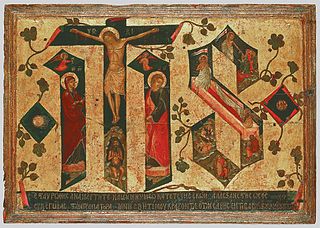
Jesus Hominum Salvator is a tempera painting by Andreas Ritzos. Ritzos was one of the founders of the Cretan School of painting. His teacher was Angelos Akotantos. Andreas Ritzos was active from 1436 to 1492. He painted in the traditional Greek-Italian Byzantine style combined with Italian Renaissance Venetian painting. The technique later became known as the maniera greca. Sixty of his works survived.

The Virgin and Child on Bronze is an egg tempera painting by Greek painter Elias Moskos. Moskos was originally from Crete. The painter migrated to Zakinthos. Two other painters with the name Moskos were active during his lifetime. They were Ioannis Moskos and Leos Moskos. All three painters were affiliated with Venice. Fifty-two of Elias's paintings survived. It is difficult to characterize the work of some painters belonging to the late Cretan School. Some artists also belong to the Heptanese School. The technical migration from the maniera Greca of Cretan-Venetian painting to the more refined Ionian-Venetian style is visible in the works of Elias Moskos and Theodoros Poulakis. His painting of the Virgin and Child drastically migrates from the traditional mannerism prevalent in Cretan painting. The painting clearly belongs to the Heptanese School. His painting of the Virgin and Child is at the Benaki Museum in Athens Greece.

Constantine and Helen is a painting by Ioannis Moskos. He was a prolific Greek painter associated with Venice and the Ionian Islands. He flourished during the Late Cretan School and early Heptanese School. Three painters with the same last name were active during the same period, the other two were Leos Moskos and Elias Moskos. Ioanni's painting style demonstrates the transition from the Late Cretan School to the early Heptanese School. He began to integrate components prevalent in the Rococo. He was a Baroque artist. According to the Neo-Hellenic Institute, forty-four of his paintings survived.
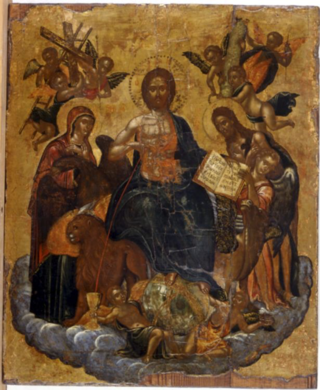
Tribute to the Eucharist was a painting made of egg tempera and gold leaf on a wood panel. The portable icon is attributed to Greek painter Michael Damaskinos. Damaskino's existing catalog features over 100 known works. He was a member of the Cretan school of painting. He was from the island of Crete. His contemporaries were Georgios Klontzas and El Greco. Damaskinos traveled all over Italy for over twenty years. He spent a significant amount of time in Venice. He adopted Italian mannerisms. He applied these new attributes to his paintings. He was friends with sculptor Alessandro Vittoria. He had a collection of drawings obtained from other Italian artists. Namely the Mannerist Parmigianino. He was also exposed to the magnificent works of Italian painter Raphael.


















